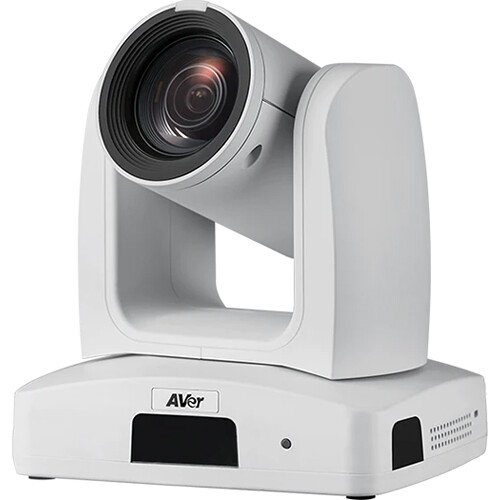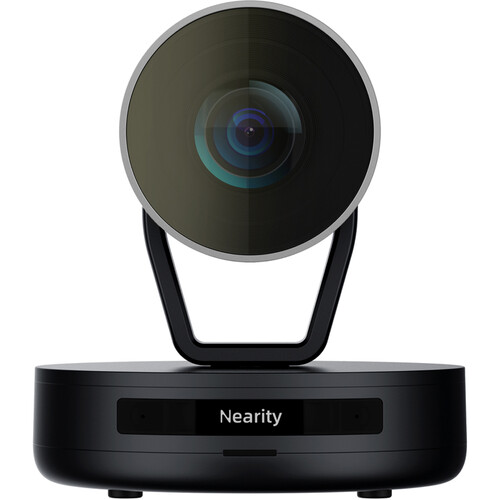TL; DR
In hybrid work settings, optical zoom yields grainy video. This guide explains optical zoom—physical lens magnification—for sharp, detailed conferences. It outlines five camera selection criteria: zoom range vs. hybrid zoom, sensor size, lens quality, connectivity options (USB, HDMI, NDI|HX), and AI-driven autofocus. Spotlighted models from the Nearity V540D (20× optical zoom, 4K UHD) for pro-large rooms to Nearity V415 (5× optical zoom, UHD, HDMI/USB-C/IP streaming, smart tracking) for compact huddle-room. It also covers troubleshooting focus hunting, motor noise, and low-light issues, plus pro tips—tripods, manual presets, WDR modes, and firmware updates—to ensure clear, professional video meetings.
Many meeting hosts struggle to capture crisp, professional-quality video when their camera relies too heavily on digital zoom rather than true optical zoom. In this guide, we’ll unlock everything you need to know about optical zoom—from the fundamental advantages it brings, to the critical factors for selecting the best digital camera with optical zoom, through to our top picks for conference-ready optical zoom cameras. We’ll also troubleshoot common issues and share pro tips so your next virtual meeting looks its absolute best.
The Advantages of Optical Zoom Camera
When it comes to high-quality video conferencing, optical zoom is your secret weapon. Unlike digital zoom—which simply crops and enlarges pixels, often resulting in grainy or blurry footage—optical zoom uses the camera’s lens elements to magnify subjects with full resolution. Below, let’s explore why optical zoom camera technology stands out.
True Image Clarity
Optical zoom preserves every pixel’s detail by physically adjusting the lens elements. This means you can zoom in on far-away presenters or whiteboard notes without losing crispness or introducing artifacts. Whether capturing facial expressions or fine text on slides, optical zoom delivers true clarity.
Superior Low-Light Performance
Because optical zoom cameras use larger, high-quality glass elements, they often gather more light than compact digital-only cameras. This translates to better performance in dimly lit conference rooms or evening events, reducing noise and enhancing overall image quality.
Consistent Autofocus and Tracking
Many optical zoom cameras incorporate advanced autofocus motors and smart tracking AI. These systems maintain sharp focus as speakers move around, ensuring a fluid, professional appearance without manual adjustments.
Flexible Field of View Range
Optical zoom cameras typically offer wide-to-telephoto focal lengths, letting you capture both a broad room overview and detailed close-ups seamlessly. This versatility is ideal for hybrid meetings where presenters may shift between a podium and a whiteboard.
Reduced Bandwidth and Processing Load
Because optical zoom retains resolution on the sensor side, there’s less need for heavy digital processing or up-scaling. This can reduce processing delays and bandwidth demands—especially important when streaming high-definition video over constrained networks.
🔗 If you have some confusion about the terms, here we provide the guide on the difference and working principles between digital zoom and optical zoom. Besides, if you want to a deeper dive into digital cameras in today’s market, don’t miss our 2025 Ultimate 4K Digital Camera Buying Guide: Key Features & Recommendations.
How to Choose a Digital Camera with Optical Zoom: 5 Critical Factors
Selecting a digital camera with optical zoom isn’t just about the zoom factor. To ensure you get the best performance for your conference meetings, consider these five critical factors:
- Zoom Range vs. Hybrid Zoom Advantage
While a high optical zoom number sounds enticing, also examine the hybrid zoom capabilities. Hybrid zoom blends optical and digital methods to extend reach—useful for occasional ultra-long shots. However, pure optical zoom quality always reigns supreme, so prioritize optical ranges that cover your typical meeting room distances.
- Sensor Size and Low-Light Sensitivity
A larger sensor captures more light, reducing noise in dim conference rooms. Look for CMOS sensors with back-illuminated structures, which further boost low-light sensitivity. This ensures clear, vibrant images even when ambient lighting is less than ideal.
- Lens Quality and Angle of View
Lens construction—number of elements, aperture range (f-stop), and anti-reflective coatings—impacts sharpness and color fidelity. Also, check the horizontal field of view (HFOV): a wider HFOV captures more participants when unzoomed, while a narrower tele end brings distant subjects closer.
- Connectivity and Control Options
Professional conferencing cameras offer versatile outputs: USB for plug-and-play, HDMI or 3G-SDI for broadcast quality, and IP/NDI|HX streaming for networked workflows. Serial control (VISCA over RS-232/422 or IP) enables remote pan-tilt-zoom (PTZ) adjustments via software controllers—ideal for unattended sessions.
- Smart Features: AI Tracking & Auto-Framing
Look for dual-lens or PTZ cameras with built-in AI tracking, auto-framing, and voice-enabled tracking. These features automatically follow active speakers, keep participants centered, and switch between room overview and close-up views—freeing you from manual camera control.
Best Optical Zoom Cameras Recommendation
Below are our top picks for best optical zoom camera solutions designed for seamless, professional video conferencing. Each excels in optical zoom, low-light performance, and easy integration with modern meeting platforms.
Nearity V540D: 20× optical zoom Camera for Pro-large Rooms
Key Features
- Dual-Lens Camera with Smart Tracking AI: Simultaneously capture wide overview and detailed close-ups, with AI-driven subject tracking for dynamic presentations.
- Sony CMOS Sensor, 40× Hybrid Zoom: Leverage 20× optical zoom with an extended hybrid range for capturing distant speakers without sacrificing clarity.
- Capture up to UHD 4K Resolution: Stream and record at crisp 4K30 for lifelike detail.
- USB, HDMI, SDI & NDI|HX Output: Flexible connectivity for any conferencing or broadcast setup.
- 58° Lens Horizontal Angle of View & 120° Panoramic Lens Angle of View: Wide coverage for full room visibility.
- VISCA IP/RS-232 Serial Control Options: Seamless PTZ control via network or serial commands.
- Daisy-Chaining with A20S Microphone & PoE Support: Simplify cabling with Power over Ethernet and integrated audio daisy-chain.
- Line/USB Audio In & Picture-in-Picture (PiP) Function: Overlay close-up and wide-angle feeds for a polished broadcast look.
Ideal for auditoriums, large conference halls, and hybrid events where you need both breadth and depth of view.
AVer TR313V2: 12× 4K PTZ Live Streaming Camera
Key Features
- 1/2.8″ 8MP 4K CMOS Sensor: Excellent low-light sensitivity for late-evening or dim audience settings.
- HDMI, 3G-SDI, USB & IP Streaming Output: Plug-and-play USB, plus professional-grade HDMI and SDI.
- Capture/Stream up to 4K30 Video: High-resolution streaming for sharp participant feeds.
- 12× Optical Zoom, 12× Digital Zoom: Balanced zoom range for most meeting room sizes.
- 6° to 70° Horizontal Field of View: Versatile framing from wide to telephoto.
- ±170° Pan, -30° to 90° Tilt Range: Full PTZ flexibility for tracking presenters anywhere on stage.
- RS-232/RS-422 Serial Control, PoE+ Support: Remote PTZ control and simplified power.
- Embedded Audio & 3.5mm Stereo Analog In: Combine audio and video in one unit.
- MJPEG/H.264/H.265/AAC Streaming Formats: Broad codec compatibility for various streaming platforms.
- Kensington Security Lock: Physical security for fixed installations.
Perfect for lecture halls, remote broadcasting, and integrations with popular streaming services.
👉 Want to learn more about how PTZ cameras enhance virtual meetings? Check out Exploring the World of Pan-Tilt-Zoom Cameras.
AVer PTZ310UNV2: 12× 4K AI NDI PTZ Camera

Key Features
- 12× Optical Zoom, Pan/Tilt/Zoom Features: Smooth mechanical zoom and motion.
- 1/2.8″ 8MP CMOS Sensor, 4K60 Resolution: Ultra-smooth high-frame-rate video for fluid motion capture.
- NDI|HX3, 3G-SDI, HDMI, IP, USB-B Output: NDI|HX3 delivers ultra-low-latency over networks—ideal for distributed setups.
- PoE+ Support, Smart Tracking: One cable for data, power, and AI-enabled tracking.
- 3.5mm Analog Audio Input: Direct integration with tabletop mics.
- RS-232/422, IR Remote Control: Multiple control pathways for flexible deployment.
Designed for enterprise-level streaming, hybrid classrooms, and large meeting rooms.
📌Explore Best NDI Cameras Recommendations for Zoom Meetings for more insights on networked camera setups
Nearity V415: 4K PTZ Camera with 5× Optical Zoom

Key Features
- 1/2.8″ CMOS 8MP 4K Sensor: Solid image quality at 4K30.
- Capture Video Resolutions up to UHD 4K30: Great for detailed participant close-ups.
- 5× Optical + 3× Digital Hybrid Zoom Lens: Compact form factor with versatile zoom.
- HDMI, USB-C, and IP Streaming Output: Modern USB-C for quick USB-Webcam mode plus IP streaming.
- Smart Tracking, Auto-Framing: Automatically keeps the speaker centered as they move.
- 85° to 21° Horizontal Angle of View: Wide-to-tele coverage for small-to-medium rooms.
- 350° Panning, ±30° Tilting: Near-complete rotation for flexible framing.
Best suited for huddle rooms, small boardrooms, and personal offices.
About Optical Zoom: Troubleshooting & Pro Tips
Even the best optical zoom camera can experience hiccups. Below are common challenges and professional tips to keep your video feed looking top-notch.
- Soft Focus at Extreme Zoom
- Cause: Lens aberrations and reduced light at tele end.
- Pro Tip: Use a tripod or gimbal-style mount to eliminate handshake. Stop down the aperture if available, improving sharpness by reducing lens aberrations.
- Hunting Autofocus or Lag
- Cause: Low contrast scenes make continuous autofocus struggle.
- Pro Tip: Switch to manual focus or use autofocus presets at critical focal lengths. Engage “face detect” or “area select” autofocus modes if your camera supports it.
- Zoom Noise Being Picked Up by Microphones
- Cause: Mechanical zoom motors can generate audible whir when adjusting.
- Pro Tip: Pre-set your framing before the meeting starts to minimize mid-session zooming. Mute your mic during any required zoom adjustments.
- Poor Performance in Backlit or High-Contrast Rooms
- Cause: Limited dynamic range leads to blown-out windows or dark subjects.
- Pro Tip: Enable WDR (wide dynamic range) or HDR modes if available. Add gentle fill lighting to balance exposure.
- Network or Bandwidth Constraints Impacting NDI Streams
- Cause: High-bitrate NDI|HX streams may overwhelm network.
- Pro Tip: Lower the bitrate or resolution, or switch to H.264/H.265 streaming modes. Use dedicated VLANs or wired Ethernet to isolate traffic.
- Firmware Compatibility and Updates
- Cause: New features or bug fixes often released by manufacturers.
- Pro Tip: Register your device and subscribe to firmware notifications. Schedule updates during off-hours to avoid meeting disruptions.
Conclusion
Optical zoom is the cornerstone of professional video conferencing, delivering unparalleled clarity, low-light performance, and reliable autofocus. By understanding the advantages of optical zoom, carefully weighing critical selection factors, and choosing from our top best optical zoom camera recommendations, you can transform any conference into an engaging, crystal-clear experience. With the right gear and a few pro tips, you’ll never worry about fuzzy faces or shaky close-ups again!









